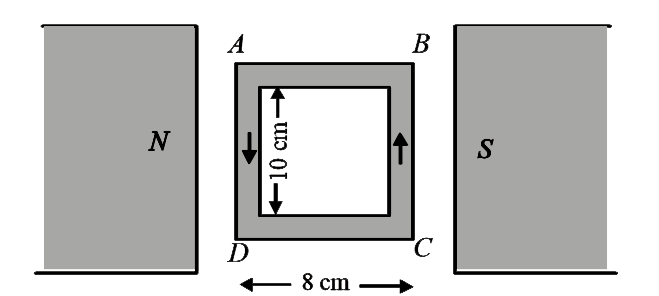A moving coil galvanometer has N number of turns in a coil of effective area. A it carries a current I. The magnetic field B is radial. The torque acting on the coil is
NA2BI
NABI2
N2ABI
NABI
The correct Answer is:D
To find the torque acting on a moving coil galvanometer, we can follow these steps:
1. Understanding the System:
- We have a coil with N turns, an effective area A, and it carries a current I. The magnetic field B is radial.
2. Magnetic Dipole Moment:
- The magnetic dipole moment →M of the coil can be defined as:
→M=N⋅I⋅→A
- Here, →A is the area vector of the coil, which is perpendicular to the plane of the coil.
3. Torque on the Coil:
- The torque →τ acting on a magnetic dipole in a magnetic field is given by the formula:
→τ=→M×→B
- The magnitude of the torque can be expressed as:
τ=M⋅B⋅sin(θ)
- Where θ is the angle between the magnetic dipole moment →M and the magnetic field →B.
4. Angle Consideration:
- In this scenario, since the magnetic field B is radial and the area vector →A is perpendicular to the plane of the coil, the angle θ between →M and →B is 90∘. Thus, sin(90∘)=1.
5. Substituting Values:
- Therefore, the torque simplifies to:
τ=M⋅B
- Substituting the expression for M:
τ=(N⋅I⋅A)⋅B
6. Final Expression:
- Thus, the torque acting on the coil is:
τ=N⋅I⋅A⋅B
Final Answer:
The torque acting on the coil is τ=NIAB.
---
- We have a coil with N turns, an effective area A, and it carries a current I. The magnetic field B is radial.
- The magnetic dipole moment →M of the coil can be defined as:
→M=N⋅I⋅→A
- Here, →A is the area vector of the coil, which is perpendicular to the plane of the coil.
- The torque →τ acting on a magnetic dipole in a magnetic field is given by the formula:
→τ=→M×→B
- The magnitude of the torque can be expressed as:
τ=M⋅B⋅sin(θ)
- Where θ is the angle between the magnetic dipole moment →M and the magnetic field →B.
- In this scenario, since the magnetic field B is radial and the area vector →A is perpendicular to the plane of the coil, the angle θ between →M and →B is 90∘. Thus, sin(90∘)=1.
- Therefore, the torque simplifies to:
τ=M⋅B
- Substituting the expression for M:
τ=(N⋅I⋅A)⋅B
- Thus, the torque acting on the coil is:
τ=N⋅I⋅A⋅B
The torque acting on the coil is τ=NIAB.
Topper's Solved these Questions
- BOOK - PHYSICS WALLAHCHAPTER - MOVING CHARGES AND MAGNETISM EXERCISE - LEVEL - 230videos
MOVING CHARGES AND MAGNETISM
- BOOK - PHYSICS WALLAHCHAPTER - MOVING CHARGES AND MAGNETISM EXERCISE - NEET PAST 5 YEARS QUESTIONS12videos
MOVING CHARGES AND MAGNETISM
- BOOK - PHYSICS WALLAHCHAPTER - MOTION IN A STRAIGHT LINEEXERCISE - NEET Past 5 Years Questions5videos
MOTION IN A STRAIGHT LINE
- BOOK - PHYSICS WALLAHCHAPTER - OSCILLATIONS EXERCISE - NEET PAST 5 YEARS QUESTIONS5videos
OSCILLATIONS
Similar Questions
Knowledge Check
- Question 1 - Select One
A moving coil galvanometer has N numbr of turns in a coil of effective area A, it carries a current I. The magnetic field B is radial. The torque acting on the coil is
ANA2B2IBNABI2CN2ABIDNABI - Question 2 - Select One
A circular coil of n turns and radius r carries a current I. The magnetic field at the center is
Aμ0nIrBμ0nI2rC2μ0nIrDμ0nI4r - Question 3 - Select One
A moving coil galvanometer has number of turns 'N' in its coil. Then its sensitivity is in proportional to :-
AN2B1N2CND√N
In a moving coil galvanometer is based on the
View SolutionA rectangular coil of area→Aand number of turns n is placed in a uniform magnetic field vecB. If the coil carries a current I, then the torque acting on the coil is given by
View SolutionA moving coil galvanometer coil has a coil of area A, number of turns N. The radial magnetic field present is B. the moment of inertia of the coil is I about its rotation axis. The torque is applied by the magnetic field on the coil of the galvanometer when current I0 passes through it and produces a deflection of π/2 of the pointer. Then answer the following questions based on the paragraph.
If the charge Q is passed almost instantaneosly through the coil, the angular velocity of the coil, immediately after this isView SolutionA moving coil galvanometer coil has a coil of area A, number of turns N. The radial magnetic field present is B. the moment of inertia of the coil is I about its rotation axis. The torque is applied by the magnetic field on the coil of the galvanometer when current I0 passes through it and produces a deflection of π/2 of the pointer. Then answer the following questions based on the paragraph.
The sensitivity of the instrument isView SolutionA moving coil galvanometer coil has a coil of area A, number of turns N. The radial magnetic field present is B. the moment of inertia of the coil is I about its rotation axis. The torque is applied by the magnetic field on the coil of the galvanometer when current I0 passes through it and produces a deflection of π/2 of the pointer. Then answer the following questions based on the paragraph.
Then the value of torsionl constant of the spring isView Solution


